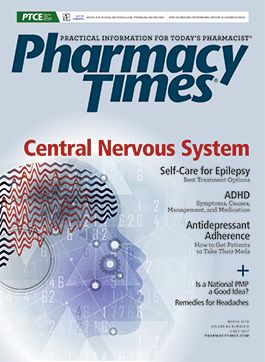Publication
Article
Pharmacy Times
ADHD: Symptoms, Causes, Management, and Medication
Author(s):
Attention-deficit/hyperactivity disorder is a neurodevelopmental mental disorder characterized by difficulty paying attention, excessive activity, and/or impulsivity that interferes with development and/or functioning.
Attention-deficit/hyperactivity disorder (ADHD) is a neurodevelopmental mental disorder characterized by difficulty paying attention, excessive activity, and/or impulsivity that interferes with development and/or functioning.1 The most common mental disorder in children, ADHD occurs more often in boys than in girls and is typically diagnosed by age 12 but can persist into adulthood.2
The number of children who received a diagnosis of ADHD rose 50% between 2007 and 2012.3 Although that number varies by the method of measure, the American Psychiatric Association reports in the Diagnostic and Statistical Manual of Mental Disorders, Fifth Edition (DSM-5) that about 5% of children have ADHD.3
SIGNS AND SYMPTOMS
The DSM-5 criteria for a diagnosis of ADHD are 3-fold. Symptoms must cause significant complications in functioning in at least 2 settings (eg, home, school, and socially) and be present for at least 6 months to a much greater extent than in others of the same age, and these criteria must be met prior to age 12.4
ADHD is divided into 3 subtypes, each with its own set of symptoms: predominantly hyperactive-impulsive (ADHD-HI or ADHD-PH), predominantly inattentive (ADHD-I or ADHD-PI), and a combination of the first 2 types (ADHD-C).
Children with ADHD-HI tend to be unable to play quietly, sit still and stay seated, and wait their turn. They often move constantly, blurt out answers, interrupt others, and talk excessively.2
Children with ADHD-I tend to be easily distracted to the point of forgetting daily activities and making mistakes, have difficulty organizing everyday tasks, often lose things, tend to daydream, and are unable to finish tasks or follow directions.2
Adult symptoms include being bored, chronically forgetful and late, depressed, disorganized, and impulsive. Adults with ADHD also can have addiction problems, anxiety, low self-esteem, mood swings, problems at work, relationship problems, trouble concentrating when reading, and difficulty managing anger. They also tend to be easily frustrated and often procrastinate.2
CAUSES AND RISK FACTORS
Although it is not known what causes ADHD,5 several risk factors exist. There may be a genetic component to ADHD because the disorder tends to run in families. ADHD is often inherited from parents, and siblings are more likely to have the disorder.
Environmental factors such as the mother’s poor nutrition, infection, cigarette smoking, alcohol use, and drug use during pregnancy, as well as the child’s exposure to environmental toxins such as lead at an early age or in utero, can make ADHD more likely to occur.1,2 Changes to the brain due to injury or chemical imbalance may also cause ADHD.2
Societal factors may come into play, as well, such as being male, being African American, having a lower socioeconomic status, living in an area with high population density, and living farther or nearer to a park.6
MANAGEMENT
Diet
ADHD diets have not been extensively studied, and the results are mixed.6 Results from research do suggest that ADHD symptoms may be exacerbated by certain foods.6 These include some dyes and preservatives, simple sugars and artificial sweeteners, salicylates (found in almonds, aspirin, cranberries, grapes, red apples, and tomatoes), and allergens such as eggs, fish, milk, peanuts, shellfish, soy, tree nuts, and wheat.7
Support Groups
A group of people in the same position, be it the parent of a child with ADHD or an adult or a child with ADHD, can lend support and acceptance, in addition to providing education about the disorder.2
Therapy
Therapy can include behavior modification to help children with ADHD replace bad behaviors with good ones; special education to provide a routine and structure; and counseling to increase self-esteem and teach positive ways to handle emotions and frustration, as well as to increase family members’ understanding of the disorder.2
MEDICATION
Stimulants are the most commonly prescribed medications for ADHD. Also called central nervous system stimulant medications, these drugs increase levels of the hormones dopamine and norepinephrine in the brain. This results in better concentration and reduced fatigue.8
Amphetamines include amphetamine, dextroamphetamine, and lisdexamfetamine, which come in extended-release and immediate-release oral formulations.8
Methamphetamine, related to amphetamine and ephedrine and also an oral drug, is indicated for ADHD but also can increase blood pressure and reduce appetite.8
Methylphenidate, considered a mild stimulant, works by increasing dopamine and norepinephrine reuptake in the brain. This medication is available in extended-release and immediate-release oral formulations, as well as a transdermal patch.8
PROGNOSIS
People with ADHD often lead happy, successful lives. However, the importance of checking in with a doctor regularly and monitoring symptoms cannot be overstated. Treatments may become ineffective over time. Many patients’ symptoms improve in early adulthood, and those individuals may be able to stop treatment.2
Kathleen Kenny, PharmD, RPh, earned her PharmD from the University of Colorado Health Sciences Center in Aurora. She has more than 25 years of experience as a community pharmacist and is a freelance clinical medical writer based in Colorado Springs, Colorado.
References
- Attention deficit hyperactivity disorder. National Institute of Mental Health website. nimh.nih.gov/health/topics/attention-deficit-hyperactivity-disorder-adhd/index.shtml. Updated March 2016. Accessed January 26, 2018.
- Attention-deficit/hyperactivity disorder (ADHD): the basics. National Institute of Mental Health website. nimh.nih.gov/health/publications/attention-deficit-hyperactivity-disorder-adhd-the-basics/index.shtml Accessed March 6, 2018.
- Attention-deficit/hyperactivity disorder (ADHD): data and statistics. cdc.gov/ncbddd/adhd/data.html. Updated January 24, 2018. Accessed January 26, 2018.
- DSM-5. ADHD Institute website. adhd-institute.com/assessment-diagnosis/diagnosis/dsm-5/. Published January 2017. Accessed February 8, 2018.
- Attention deficit hyperactivity disorder. MedlinePlus website. medlineplus.gov/attentiondeficithyperactivitydisorder.html. Updated December 11, 2017. Accessed January 26, 2018.
- Why sugar is kryptonite for ADHD brains. ADDitude site. additudemag.com/adhd-diet-nutrition-sugar/. Accessed March 6, 2018.
- Amen T. 9 food rules for ADHD families: what to eat, what to avoid. ADDitude website. additudemag.com/best-foods-for-adhd-diet-nutrition/. Accessed March 6, 2018.
- Cherney K. ADHD medications list. Healthline website. healthline.com/health/adhd/medication-list. Accessed January 31, 2018.


MDMA Rejected: The Story of a Study Participant Entrenched in Ethical Violations and a Data Breach





